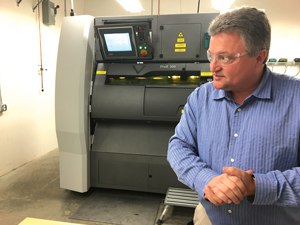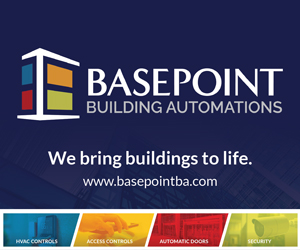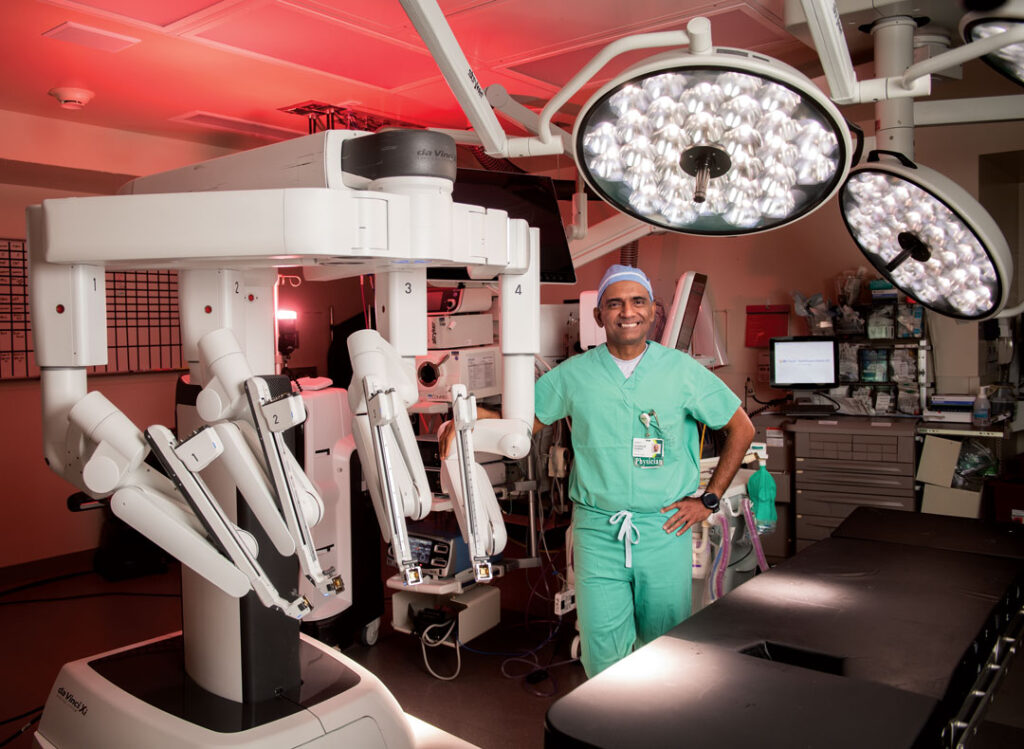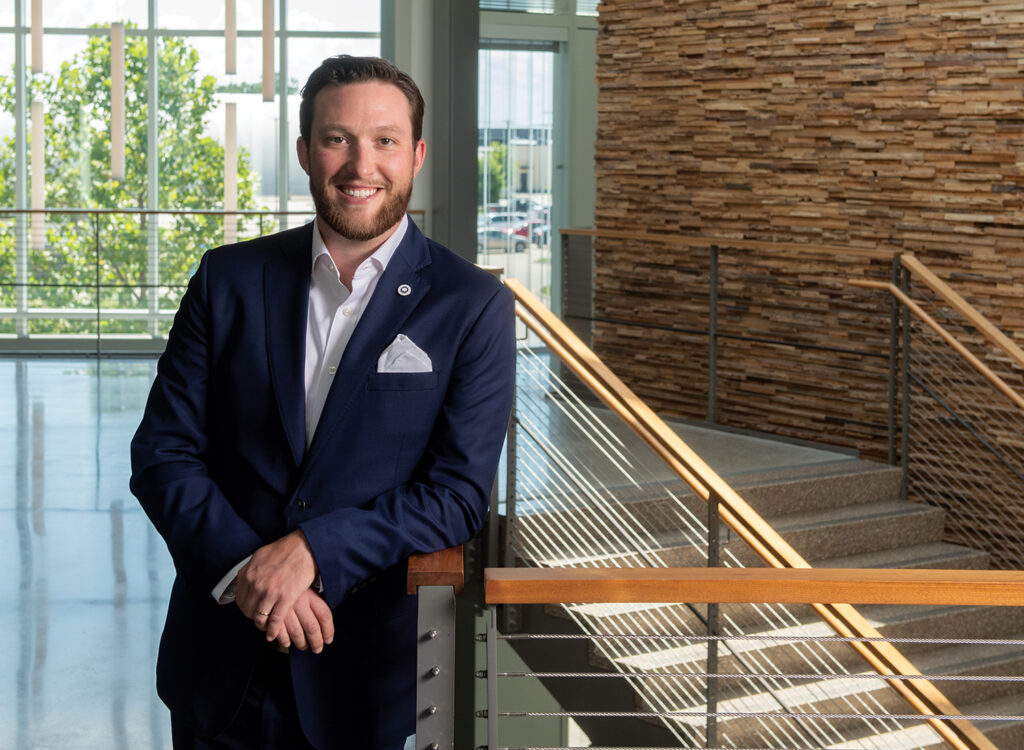3-D Profits?
ISU’s metal printer combines laser, ingenuity, engineering, efficiency

PERRY BEEMAN May 6, 2016 | 11:00 am
4 min read time
989 wordsBusiness Record Insider, Innovation and EntrepreneurshipPella Corp. has been making plastic parts with a 3-D printer for a dozen years. The window- and door-making giant has a long history of working with Iowa State University’s Center for Industrial Research and Service, known as CIRAS, on new ways to make manufacturing efficient, and therefore profitable.
But Pella production manager Kurtis Webb is especially excited about one of his company’s latest collaborations with ISU — work to experiment with ISU’s new metal 3-D printer.
The $900,000 contraption, installed in October, can make tools and parts by depositing layer upon layer of steel dust — each one less than the thickness of a human hair — and fixing the dust in place with a laser. It has the potential to save Iowa manufacturers time and money, and to present solutions they might not have considered.
CIRAS bought the machine with help from a federal grant, the Iowa Economic Development Authority and the ISU College of Engineering.
CIRAS recently demonstrated the 3-D printer for its board members, Central Iowa business executives and reporters. As the device ran laser over steel dust to make another test product, workers showed off a table of geometric creations pulled from the machine earlier, evidence of the large range of shapes and minute details the printer can handle.
The process comes with a couple of advantages, said Chris Hill, head of CIRAS’ technology assistance initiatives. Companies don’t have to build one mold and hope it will work. The 3-D printer can make a test product, and easily make adjustments for a second, third or fourth version.
In addition, some drawbacks of conventional molding can be sidestepped. For example, parts can have a curved channel in them to allow air or water to more uniformly cool the metal. That sidesteps the warping that can happen with a conventional straight channel through a part.
“We’ve been working with 3-D printing with plastic for a dozen years,” Webb said in an interview. “With metal, this is a whole new area.”
Webb said the metal printing could be especially promising in making tools, gauges and fixtures, which hold the part that is being made. The process should reduce costs, and will allow manufacturers to make shapes that wouldn’t have been an option before.
“We can accomplish things that had been impossible to do, or too expensive,” he added.
Another advantage for Pella — or any Iowa manufacturer — is the potential to get a product to market faster.
“When we talk about product development, it can speed up the time to market and also it could be cheaper,” Webb said. “We can print a few, check it out and make adjustments. It could cut production time by 75 percent.”
Webb said the technology seems especially promising at Pella for research and development and part production. The company is still debating how to use the technology in the production of windows and doors.
Other companies might find the technology helpful in duplicating hard-to-find or off-the-market parts for old cabinets or antiques, CIRAS staff members said.
Hill said the 3-D metal printer is likely to be more of an experiment station for a while, because the technology probably isn’t ready for wide commercial use. Some parts can take 24 hours to print. And businesses still are trying to figure out what they can make in a chamber that measures less than 10 inches by 10 inches by 12 inches.
“Is this technology ready for everyday use? No,” Hill said. But now is the time for manufacturers to explore what they can do with the technology as it progresses, so they can be ready when it becomes commercially viable, he added.
Pella worked with ISU on a couple of test items. One took five hours to print; the other, 13 hours. Webb doesn’t want to say much about them, but one was a gauge.
“As I show it around, people look at it and you can see the lights going on in their heads,” Webb said.
There was more than than one head scratched at ISU during the open house and media briefing. The CIRAS team had printed two sets of fully functioning scissors, one of which was printed as one piece. They were sharp, and they worked.
Other items were printed with holes so small that getting a straightened-out paper clip into them would have been tough.
Hill told the ISU audience that he asks manufacturers to tell him what they are trying to accomplish, rather than exactly what they want built. Often, the university can come up with a solution that is cheaper, quicker to make and may even look completely different that what was originally planned.
“Everybody has to change their way of thinking about how to make things work,” Jim Johnson, chief operating officer at Frog Legs Inc. in Ottumwa, told ISU officials. “Otherwise, there will be some companies who change and take all the business.”
Johnson’s firm, which makes wheelchair suspension systems, is one of several Iowa companies now working with CIRAS to explore the technique, also known as additive manufacturing. Calls are pouring in after word got around about the device.
Quatro Composites of Orange City worked with CIRAS on a device that helps employees drill holes in the right places. The five-axis fixture helped the company assemble parts quicker too.
“Now the design rules are broken,” company program manager Jack Ward told ISU. “So now I can go do all kinds of crazy stuff, and I can actually build it. Because I can print it, I can do stuff that I couldn’t actually do before.”
For manufacturers in Iowa, Pella’s Webb said, 3-D printing could change whole industries: “I see it as one of those enabling technologies to make us more competitive. Throughout Iowa, manufacturers will know how to leverage it. When they do, they will be ahead of the competition.”
Added Webb: “In five or 10 years, we will all be amazed.”









